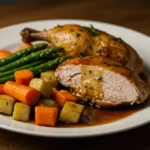There’s something magical about a Sunday roast, especially when it involves succulent chicken and perfectly cooked veggies. This timeless tradition brings families together, creating moments of joy and satisfaction around the dinner table. In this comprehensive guide, we’ll explore everything you need to know about preparing the perfect Sunday roast chicken and veggies. From sourcing the finest ingredients to serving up a meal that will have everyone asking for seconds, we’ve got you covered.
Ingredients
To prepare a delicious Sunday roast chicken and veggies, you’ll need a selection of fresh ingredients. Here’s what you’ll need:
For the Roast Chicken
- 1 whole chicken (about 4-5 pounds)
- 4 tablespoons olive oil
- 2 teaspoons salt
- 1 teaspoon black pepper
- 1 lemon, halved
- 4 cloves garlic, minced
- 2 sprigs rosemary
- 2 sprigs thyme
For the Vegetables
- 4 large carrots, peeled and sliced
- 4 medium potatoes, quartered
- 1 large onion, cut into wedges
- 2 cups Brussels sprouts, halved
- 2 tablespoons olive oil
- 1 teaspoon salt
- 1 teaspoon black pepper
Optional Extras
- 1 tablespoon butter (for extra richness)
- 1/2 cup chicken broth (for basting)
- 1 tablespoon balsamic vinegar (for a hint of sweetness)
Instructions
Creating a Sunday roast chicken with veggies is straightforward if you follow these steps:
Preparing the Chicken
- Preheat the Oven: Preheat your oven to 425°F (220°C).
- Clean and Season the Chicken: Rinse the chicken under cold water and pat dry with paper towels. Rub olive oil over the skin, then season with salt, pepper, and minced garlic. Squeeze the lemon halves over the chicken, placing the squeezed halves inside the cavity along with rosemary and thyme.
- Truss the Chicken: Tie the legs together using kitchen twine to ensure even cooking.
Roasting the Chicken
- Place in the Oven: Place the chicken breast-side up on a roasting rack in a roasting pan. Optionally, pour chicken broth into the bottom of the pan for added moisture.
- Initial Roast: Roast the chicken for 15 minutes at 425°F (220°C) to brown the skin.
- Reduce Heat: Lower the oven temperature to 375°F (190°C) and continue roasting for approximately 1 hour, basting occasionally with pan juices. The chicken is done when it reaches an internal temperature of 165°F (75°C) in the thickest part.
Preparing the Vegetables
- Prep the Veggies: While the chicken is roasting, toss the carrots, potatoes, onion, and Brussels sprouts with olive oil, salt, and pepper.
- Roast the Veggies: Spread the vegetables on a baking sheet and place in the oven during the last 30-40 minutes of the chicken’s cooking time. Stir halfway through for even cooking.
Finishing Touches
- Rest the Chicken: Once cooked, remove the chicken from the oven and let it rest for 10-15 minutes before carving. This allows the juices to redistribute.
- Serve: Arrange the carved chicken pieces and roasted vegetables on a serving platter. Drizzle with balsamic vinegar and dot with butter if using.
Nutrition Facts
Understanding the nutritional content of your Sunday roast can help you make informed dietary choices. Here’s a general breakdown:
- Calories: Approximately 650 kcal per serving
- Protein: 45g
- Fat: 40g
- Carbohydrates: 35g
- Sodium: 950mg
Note: Nutrition facts are estimated and can vary based on specific ingredients used.
How to Serve
Serving your Sunday roast chicken and veggies is not just about the food itself; it’s also about creating an experience that brings people together and enhances the joy of the meal. Here are some detailed suggestions to elevate your presentation and serving strategy:
Presentation
1. Choose the Right Platter: Begin with a large, warm serving platter. A wooden, ceramic, or elegant porcelain dish can add a touch of sophistication to your meal. Ensure the platter is large enough to hold all the components without crowding, allowing each element to shine.
2. Artistic Arrangement: Arrange the carved chicken pieces in the center of the platter. Consider using different sizes and shapes of chicken pieces—thighs, breasts, and drumsticks—to create visual interest. Surround the chicken with a colorful array of roasted vegetables, such as golden carrots, vibrant bell peppers, and deep green broccoli. You might also consider using a variety of textures, like crispy Brussels sprouts or creamy potatoes, to make the dish more dynamic.
3. Garnishing: Enhance the visual appeal further by garnishing the platter with fresh herbs, such as rosemary or thyme. A sprinkle of chopped parsley can add a pop of color and freshness. For an extra touch, consider drizzling a light olive oil or balsamic glaze over the vegetables just before serving, which not only enhances the look but also adds flavor.
4. Table Setting: Complement your serving platter with a well-set dining table. Use cloth napkins, elegant dinnerware, and polished cutlery to create an inviting atmosphere. Consider adding a centerpiece—like a simple floral arrangement or candles—to enhance the dining experience.
Accompaniments
1. Bread Options: A side of crusty bread or freshly baked dinner rolls is a perfect accompaniment. Consider offering a variety, such as sourdough, whole grain, or garlic bread, to cater to different preferences. You might also serve some whipped butter infused with herbs or garlic for added flavor.
2. Sauces and Condiments: Gravy is a classic choice, but don’t shy away from experimenting with other sauces. A light herb sauce, such as chimichurri or a lemon-dill vinaigrette, can add brightness to the dish. Additionally, consider serving a tangy mustard or a homemade aioli on the side, which can provide a delightful contrast to the rich flavors of the roast.
3. Sides and Salads: While the roast chicken and veggies are the stars of the show, offering a fresh salad can balance the meal. A simple mixed green salad with a light vinaigrette can cleanse the palate. You might also consider seasonal sides such as roasted seasonal squash or a quinoa salad for added nutrition and variety.
Wine Pairing
1. White Wine Selections: A crisp white wine like Chardonnay or Sauvignon Blanc pairs beautifully with roast chicken, complementing the meat’s flavors without overpowering them. If you prefer something with a bit more complexity, look for a lightly oaked Chardonnay, which adds a creamy texture that matches well with roasted vegetables.
2. Red Wine Recommendations: If you’re leaning toward red wine, a light-bodied Pinot Noir is an excellent choice. Its fruity notes and subtle earthiness will enhance the flavors of the chicken and the roasted veggies. For those who enjoy a bit more body, a Grenache or a Gamay can also work well, particularly if your vegetables include sweeter options like roasted carrots or sweet potatoes.
3. Serving Temperature: Remember to serve your wines at the ideal temperature—white wines should be chilled, while red wines are best served slightly below room temperature. This not only enhances the flavor but also contributes to a more enjoyable dining experience.
Final Touches
As you serve the meal, encourage your guests to help themselves, fostering a communal atmosphere. Sharing a meal is about connection, so take the time to engage in conversation and enjoy the fruits of your labor together. With thoughtful presentation, delicious accompaniments, and carefully selected wine pairings, your Sunday roast chicken dinner will not only be a feast for the senses but also a cherished memory for all who gather around the table.
Additional Tips
To elevate your Sunday roast into a culinary experience that delights the senses and brings loved ones together, consider the following detailed tips:
Season in Advance
One of the most effective ways to enhance the flavor of your roast chicken is to season it in advance. By applying salt and herbs the night before, you allow the seasoning to penetrate the meat, resulting in a richer, more complex flavor profile. Here’s how to do it:
- Choose Your Seasonings: Opt for a blend of kosher salt, freshly cracked black pepper, and your favorite herbs. Rosemary, thyme, and sage are classic choices that complement chicken beautifully. You can also incorporate garlic powder or lemon zest for an added punch.
- Apply Generously: Rub the seasoning all over the chicken, making sure to get into the cavity and under the skin wherever possible. This will ensure that the flavors are not just on the surface but infused throughout the meat.
- Resting Period: After seasoning, place the chicken on a wire rack set over a baking sheet. Leave it uncovered in the refrigerator overnight. This process not only allows the flavors to meld but also helps to dry out the skin, which is crucial for achieving that coveted crispy texture during roasting.
Spatchcocking
If you’re pressed for time but still want to serve a perfectly roasted chicken, consider spatchcocking, or butterflying, the bird. This technique involves removing the backbone of the chicken, allowing it to lay flat, which promotes even cooking and reduces roasting time. Here’s how to do it:
- Prepare Your Tools: You’ll need a sharp kitchen scissors or a boning knife and a cutting board.
- Remove the Backbone: Place the chicken breast-side down. Use the scissors or knife to cut along either side of the backbone. Remove it completely and save it for making stock later.
- Flatten the Chicken: Open up the chicken like a book and press down on the breastbone to flatten it. You’ll hear a crack, which is normal. This method not only cuts down on cooking time but also allows for a greater surface area, yielding more crispy skin.
- Cooking Time: A spatchcocked chicken typically cooks in about 45-60 minutes at 425°F (220°C), depending on the size, so adjust your cooking time accordingly.
Crispy Skin
Achieving that golden, crispy skin is a hallmark of a great roast chicken. To maximize crispiness, follow these steps:
- Drying the Skin: Moisture is the enemy of crispiness. After washing the chicken (if you choose to), pat it dry thoroughly with paper towels. For even better results, consider air-drying the chicken in the refrigerator for several hours or overnight, as mentioned earlier.
- High Heat Roasting: Start roasting your chicken at a high temperature (around 450°F or 232°C) for the first 20-30 minutes to render the fat from the skin and create a beautiful crust. You can then lower the temperature to finish cooking without burning the skin.
- Use of Fats: A light coating of oil or melted butter can help promote browning. Be sure to brush the skin with oil or butter right before placing it in the oven.
- Resting Period: After roasting, let the chicken rest for at least 15-20 minutes before carving. This allows the juices to redistribute, keeping the meat moist and the skin crisp.
Vegetable Variations
While traditional roasted vegetables like carrots and potatoes are classic accompaniments, don’t hesitate to get creative with your vegetable selection. Here are some ideas:
- Root Vegetables: Incorporate a variety of root vegetables for added sweetness and texture. Parsnips and sweet potatoes can bring a lovely caramelization when roasted, while turnips or beets add earthiness.
- Seasonal Picks: Take advantage of seasonal produce. In the fall, butternut squash and brussels sprouts are excellent choices. In the summer, zucchini and bell peppers can add vibrant color and flavor.
- Flavor Infusion: Toss your vegetables in the same seasoning mix you used for the chicken to create a cohesive flavor throughout your meal. You can also add fresh herbs or a splash of balsamic vinegar right before roasting for a flavor boost.
- Roasting Techniques: Consider roasting the vegetables separately, especially if they require different cooking times. This way, you can ensure everything is perfectly cooked and avoid overcooked or mushy veggies.
By employing these additional tips, your Sunday roast will not only be a delightful meal but also a cherished tradition that brings family and friends together around the table. Enjoy the process, embrace experimentation, and make this culinary experience uniquely yours!
FAQs
Q: Can I use chicken pieces instead of a whole chicken?
Yes, you can use chicken pieces such as thighs and drumsticks for quicker cooking times. Adjust the roasting time accordingly.
Q: How do I store leftovers?
Store leftovers in an airtight container in the refrigerator for up to 3 days. Reheat in the oven to maintain crispness.
Q: Can I prepare the veggies ahead of time?
Absolutely! You can chop and season the veggies a day ahead. Store them in a sealed container in the refrigerator until ready to roast.
Q: What should I do if my chicken isn’t browning?
If the chicken isn’t browning, increase the oven temperature to 450°F (230°C) for the last 10 minutes of roasting.
Q: Is there a vegetarian alternative to this recipe?
Certainly! Substitute the chicken with a meat alternative like tofu or tempeh, and use vegetable broth for basting.
Conclusion
A Sunday roast chicken with perfectly cooked veggies is more than just a meal—it’s an experience that brings loved ones together. With this guide, you’re equipped with the knowledge and tips to create an unforgettable feast. Whether you’re a seasoned cook or a beginner in the kitchen, the joy of a successfully executed roast will always be a rewarding experience. So gather your ingredients, set your table, and savor the delightful flavors of this classic dish. Happy roasting!
Print
Sunday Roast Chicken and Veggies
Ingredients
To prepare a delicious Sunday roast chicken and veggies, you’ll need a selection of fresh ingredients. Here’s what you’ll need:
For the Roast Chicken
- 1 whole chicken (about 4–5 pounds)
- 4 tablespoons olive oil
- 2 teaspoons salt
- 1 teaspoon black pepper
- 1 lemon, halved
- 4 cloves garlic, minced
- 2 sprigs rosemary
- 2 sprigs thyme
For the Vegetables
- 4 large carrots, peeled and sliced
- 4 medium potatoes, quartered
- 1 large onion, cut into wedges
- 2 cups Brussels sprouts, halved
- 2 tablespoons olive oil
- 1 teaspoon salt
- 1 teaspoon black pepper
Optional Extras
- 1 tablespoon butter (for extra richness)
- 1/2 cup chicken broth (for basting)
- 1 tablespoon balsamic vinegar (for a hint of sweetness)
Instructions
Creating a Sunday roast chicken with veggies is straightforward if you follow these steps:
Preparing the Chicken
- Preheat the Oven: Preheat your oven to 425°F (220°C).
- Clean and Season the Chicken: Rinse the chicken under cold water and pat dry with paper towels. Rub olive oil over the skin, then season with salt, pepper, and minced garlic. Squeeze the lemon halves over the chicken, placing the squeezed halves inside the cavity along with rosemary and thyme.
- Truss the Chicken: Tie the legs together using kitchen twine to ensure even cooking.
Roasting the Chicken
- Place in the Oven: Place the chicken breast-side up on a roasting rack in a roasting pan. Optionally, pour chicken broth into the bottom of the pan for added moisture.
- Initial Roast: Roast the chicken for 15 minutes at 425°F (220°C) to brown the skin.
- Reduce Heat: Lower the oven temperature to 375°F (190°C) and continue roasting for approximately 1 hour, basting occasionally with pan juices. The chicken is done when it reaches an internal temperature of 165°F (75°C) in the thickest part.
Preparing the Vegetables
- Prep the Veggies: While the chicken is roasting, toss the carrots, potatoes, onion, and Brussels sprouts with olive oil, salt, and pepper.
- Roast the Veggies: Spread the vegetables on a baking sheet and place in the oven during the last 30-40 minutes of the chicken’s cooking time. Stir halfway through for even cooking.
Finishing Touches
- Rest the Chicken: Once cooked, remove the chicken from the oven and let it rest for 10-15 minutes before carving. This allows the juices to redistribute.
- Serve: Arrange the carved chicken pieces and roasted vegetables on a serving platter. Drizzle with balsamic vinegar and dot with butter if using.
Nutrition
- Serving Size: one normal portion
- Calories: 650
- Sodium: 950mg
- Fat: 40g
- Carbohydrates: 35g
- Protein: 45g






